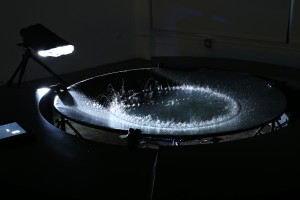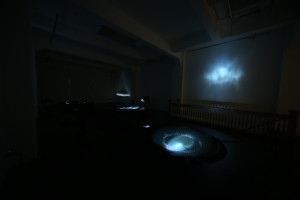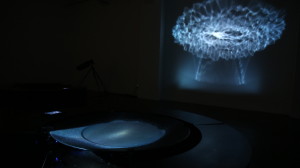
DAVID GURMAN – REFLECTOR
(photo credit J Jones, 2014)
Exhibition: The Reflector Project
Dates: September 12 “ October 18th , 2014
Reception: Friday September 12, 6-8pm
Place: The Luggage Store
Address: 1007 Market Street (near 6th)
San Francisco, CA 94103
Telephone: 415. 255 5971
Hours: Wednesday “ Saturday, 12-5 and by appointment
Artist Talk with David Gurman and special guests (collaborators, tba)
Date: Wednesday, September 24, 2014
Time 6-8pm
Admission Free
Title: The Reflector Project
Artist: David Gurman
The Luggage Store is pleased to present œThe Reflector Project, a solo exhibition and work in progress for over two years by David Gurman.
Reflector: A Real-Time Memorial to Landscapes where Human Intervention Registers as Earthquakes: David Gurman is collaborating with a team of scientists, engineers, designers and fabricators to create an installation driven by earthquake data from conflict areas around the world. The first iteration will open at the Luggage Store Gallery, where installation attendees can select from and abstractly experience in real-time, data from a number of landscapes in conflict, from Bombs in Southern Israel to Mining Explosions in South Dakota to Glacial Earthquakes of the Antarctic.
Description of the experience:
At the Reflector Installation viewers sit by the side of three circular, water filled, reflecting pools and choose on an ipad from a list of zones around the world to visualize ground motion, earthquake data from bombs in Syria to mining explosions in South Dakota to glacial earthquakes of the Antarctic, amongst others: southern Israel, Nevada test site, South Dakota, Kabul, Syria, Central Park, Antarctica. The surface of the pools are disturbed with waves “ proportional to whatever™s going on in each one of the zones at that moment. Light, from custom designed LED projectors is reflected off the surface of the pools and immerses the viewer, and the architecture, in light wave disturbance patterns. If there™s a bomb explosion or a mortar attack in, say, Syria, a viewer will see proportionally modeled shadow play on the walls that looks somewhat like an explosion, in real time.
Hazel White Narrative:
The pervasive fear [now] is not what nature can do to us, but what we might do to it. ”Rosalind Williams, Notes on the Underground
David Gurman™s Reflector project at the Luggage Store gallery invites us to step into an experience of distant human conflict and environmental devastation in real-time. A mortar hits the ground near the Syrian border, or blasting starts up in a mine in South Dakota, and seismic data from there sets waves moving across a pool in front of us, while light directed at the surface reflects off it and explodes over the gallery walls. As we walk by chance in front of the light, we see one another™s shadows embedded in the explosions.
Time collapses here: within seconds of the event occurring, we are witnessing it on the water. The ground movement data arrives at the gallery from IRIS Data Management Center, which collects real-time seismic movements globally. But does space collapse also”can we experience the violence of the shocks, most of them human-made, in places where we have never stood? Can distance be overcome by an immersive kinesthetic experience of live data flowing from a portal into our bodies? And, Gurman is asking, might that allow us œto understand the world again? He™s skeptical, but also serious. This project, a work in progress for several years, launched at the Luggage Store gallery and being funded toward installation at the Capitol Rotunda or the U.N. Plaza, is an experiment in post-Cartesian consciousness.
The installation includes three circular pools, each with benches around it and an interactive touch screen, where you can see the data arriving as soon as you select a geographic zone: southern Israel, Nevada test site, South Dakota, Kabul, Syria, Central Park, Antarctica. We might expect Central Park to provide a physicalized experience of peace, and Antarctica maybe of a glacial earthquake; the other zones are more likely registering weapons testing, ground fighting, civil war, and natural resource extraction.
Gurman says of this work, œIt™s a safe space to project yourself into a zone you™ve never been to. Something terrible/terrific is happening there; you want to know it, be engaged, but you can™t, or you don™t. I wanted to create an experience that allows us to imagine ourselves and our families in the context of those events as they occur. We are so small in relation to the Earth, but now our impacts on it (and one another) are registering on the scale of natural disasters.
Gurman and the scientists and technologists collaborating with him are taking data distant from us and œputting a datascope on it and trying to understand the world in a new way, he says. In this installation, the team makes data vibrant in the body and in the space around it, pushing toward a different sense of connection to others and distant events, which Gurman is hypothesizing is œa new human sense in its infancy.
”Hazel White
Materials and Dimensions:
40™x20x20™
Seismic data feeds via IRIS Data Management Center and GSN, Antelope Realtime Seismic Monitoring Software, Custom Software, Custom LED Projection Lights, Steel Rings, Neoprene Rubber Membrane, Tripods, Transducers, Amplifiers, Macbook Pro, Touch Screens, Water.
David Gurman BIO:
David Gurman, MFA, is a data artist, Design Director, Co Founder of MAPPR, and TED Fellow, internationally recognized for using real time data and citizen reportage from conflict zones to drive kinetic art installations. His “real-time memorials” are beacons for events we hear about but have no access to, broadening awareness and bridging distant cultures and landscapes. His work has been included in national and international exhibitions and recognized by the FWA, WordPress, Communication Arts, TED, , Headlands Center for the Arts, the Center for Cultural Innovation, the Toby Devan Lewis Fellowship, the Eureka Fellowship,
Data Feeds:
Southern Israel “ Ground Fighting and Natural Seismic Activity
Nevada Test Site “ Ordinance testing and Natural Seismic Activity
South Dakota “ Mining Coal (Powder River Basin) and Natural Seismic Activity
Kabul, Afghanistan “ IED™s and Natural Seismic Activity
Syria Border – Civil War and Natural Seismic Activity
Central Park – NYC
Antarctica – Glacial Quakes
Team:
Lead Artist: David Gurman
Seismologist: Joshua Stachnik
Optical Scientist: Helen Gourley
Mechanical Engineer: Darrell Gourley
Electrical Engineer: Donald Day
Software Engineer, Project Manager: Robert Michael Foster
Software Engineer: Jim Altieri
Machining and Fabrication: Kevin Binkert
Research and Prototyping: Eric Bissell
Support:
This Project is made by possible by generous support from the Andy Warhol foundation for the Visual Arts, the Center for Cultural Innovation, the Wattis Foundation, the Fleishhacker Foundation, and the National Endowment for the Arts, Boulder Real Time Technologies, Crowson Technologies, The Pheobus Company and Grants for the Arts of the Hotel Tax Fund.
The Luggage Store:
The Luggage Store ; One of Francisco™s leading non profit multi disciplinary arts organizations established in 1987, with three venues in downtown San Francisco, the luggage store (1007 Market Street) The luggage store annex (aka 509 Cultural Center) at 509 Ellis Street and the adjacentTenderloin National Forest in Cohen Alley (a green community commons for public art and social interventions). The luggage store™s vital exhibition, performing arts public arts and arts education programs are designed to broaden social and aesthetic networks by encouraging the flow of images and ideas between different cultural and economic communities.

